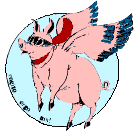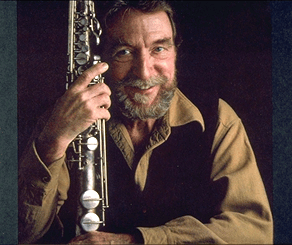jpt is honored to share some of the recollections he is currently weaving into a book (the latest in a series of memoirs of his life and work), and we are running a curriculum vitae to document the remarkable range and variety of his jazz life. Over the next issues we will continue the record of his work and hope to run more episodes from his memoirs. He is still playing with a jazz quartet, now more often clarinet than soprano sax, but always in the vein of the pure Creole New Orleans style.
![]()
![]()
![]()
By Henry Blackburn,
Copyright 2007
Jimmy McPartland’s Case of Nerves
Wednesday, July 2nd, 1947
After a long day of interviews, I returned to the loop via fast electric coach from the
I finished a beer and left the bar, strolling west on
I quickly replied, “Oh, yes, and that lady on piano was putting out some especially nice stuff.” He grunted, “Yeah, that’s my wife!”
Despite this horrid beginning, the musician apparently took a liking to a fresh and naif med student—more likely he needed a good-listener—and invited me for a drink “down the street a ways,” justifying his heavy consumption that evening by the “weight of the world” on his shoulders. The light dawned belatedly on me that he was cornetist Jimmy McPartland, along with his connection to the pianist, Marian McPartland.
I then recalled that Jimmy was a former member of the Ben Pollock and Benny Goodman bands and was now on his own. When I told him I was a medical student from
By now, to my neophyte doctor’s eye, Jimmy seemed a victim of painful anxiety; my heart reached out to him. We talked music,
McPartland physically was a powerful man, a tense, mesomorphic Irish coil. By this time, over our second drink, he was showing photographs of his stunning 17-year-old daughter and of his second wife, Marian. I hardly knew how to respond to such an intense yet gregarious, idealistic yet troubled, musician-showman but simply tried to be an attentive and sympathetic listener.
Because of his great physical presence and musical competence, it was a surprise when he confided that he still got terrible stage fright, “particularly when friends are in the audience.” This after 25 years in the big time! He was obviously searching, but his philosophy was poorly organized at three o’clock in the morning. After a night of performing and putting down a few, it was mainly platitudes: “Generalities are the thing. Everything is comparative!” Indeed.
As we headed down the street toward his gym, I begged off from joining him in the sauna, and we parted in the smoggy, pre-dawn damp, he to work off his panic and me to a temporary bed at
| A SCALE-MODEL DIORAMA OF THE MUSICAL LIFE OF HENRY |
![]() Musical Chronology. A Sometimes Painful, often Ecstatic Life on the Fringe (1931-2007)
Musical Chronology. A Sometimes Painful, often Ecstatic Life on the Fringe (1931-2007)
Played triangle in the “Anvil Chorus” during a first grade musical production in
Played violin with an excruciating youth orchestra, 1933-34, touring CCC Camps in the
Exposed from age 8 to 12 to Thelma Smith, a wonderful nanny for my infant brother in small-town
Took up clarinet at age 14 in a competitive high school band in Ocala, Florida in 1939 and won a Class C (lowest experience) solo award despite a judge’s perspicacious criticism: “Attack too strong, probably from playing too much jazz!” (Turned out the judge walked his dog past my house each evening and thus had “outside” information.) The Ocala High band played and marched atrociously in the Orange Bowl State Band Contest, New Year’s Day, 1939, in perfect alignment, but at a 20 degree angle to the yard lines. We disgraced our institution.
Technical advance arrested after move to
Played in
Gainesville High School, 1941-42, organized a truly awful five-piece band that played for student assemblies, doing such unswinging ballads as, “Careless,” “Chloe,” and “I’m Confessing That I Love You,” to standing ovations, nevertheless, by swing-starved student body. Age 17.
Attended an “all-colored dance” in an
At Florida Southern College, as a freshman in 1942-43, drafted into George Toy’s infamous dance band, mainly because the good musicians were gone to war. Played college cotillions, sleazy country dances, park board performances, and Saturday night officers’ club dances at
First out-of-town Saturday night club gig, 1943, in a dangerous nite-spot in
![]()
College dance band success at Florida Southern College in 1942-43, playing “Dark Eyes” and “Sheik of Araby,” rapidly, roundly and repeatedly, mainly in the lower register. Band “made out” with the coeds after such performances. Age 17-18.
Helped organize a U.S. Navy swing band of 20 pieces at
Played second tenor saxophone with U.S. Navy Swing Band at Biltmore Hotel Veterans Benefit Gala in 1944, the sax section 12 inches from Sally Rand’s posterior (whose age at the time was about 45, based on a reasonable guess of her age at her more famous performance in the
Attended
U.S. Navy Marching Band at the Admiral of the Fleets inspection, 1944, while hundreds of mates stood at full attention a dog and a bitch were hung up with frantic contortions a few yards behind the admiral out of his view. Never has a military force in history maintained full dress attention and demeanor so well under such an overwhelming provocation. Several who collapsed from choked mirth were reported to have perforated diaphragms. Age 19.
U.S. Naval Unit,
As swing died post-war, I made a rapid evolution to traditional jazz of the Dixie ilk, influenced by Bob Crosby’s Bobcats and the
Played jazz standards with black
Attended the famous Hall of Fame concert nationally broadcast as a Parade of Stars at the Orchestra Hall in New Orleans with Bunk, Louis Armstrong, Sydney Bechet, JC Higginbottom, et al. 1946, age 21.
A whole night of pub crawling and jazz seeking (Victory Club and Lee Collins) on Chicago’s near-northside in 1947 with Muggsy Spanier, famous cornetist and former patient of Alton Ocshner, who saved Muggsy’s life from a bleeding ulcer (memorialized in “Touro Infirmary Blues”). age 22.
During
Jazz history continued next issue. . .
__________________________________ Back to top ^
Another Life: Professional CV of
Henry Blackburn M.D. (1925- )
Henry Blackburn was educated at the University of Miami and the Tulane University School of Medicine, and served internships and residencies at Chicago Northwestern Memorial, the American Hospital of Paris, and the University of Minnesota. He established clinics for Methodist Missions in Oriente Province, Cuba in 1949 and served as US Public Health Service officer for the Displaced Persons Act in Austria from 1950 to 1953. After a research rotation at the Laboratory of Physiological Hygiene at Minnesota in 1954 he joined its faculty in 1956, becoming Project Officer for the Seven Countries Study of Heart Diseases in Greece, Yugoslavia, Italy, the Netherlands, Finland, Japan,and USA from 1957 to 1972. That year he became Director of the Laboratory upon Ancel Keys’s retirement. He became chairman of the Division of Epidemiology in the School of Public Health at Minnesota in 1983, where he remains in active retirement since 1996.
The Seven Countries role and two signature publications initiated his research career: “The Electrocardiogram in Population Studies” (aka The Minnesota Code: Circulation, 1960) and “Cardiovascular Survey Methods” with Geoffrey Rose (World Health Organization, 1968). From an initial focus on survey methods his interests developed in risk prediction with the resting and exercise electrocardiogram and with physiological testing, during which studies he became involved with design and analysis of pilot trials in physical activity, in the University Group Diabetes Program, the Coronary Drug Project, and eventually with the several NIH-sponsored multicenter preventive trials of the 1970s and 80s.
His Seven Countries Study experience led him to propose community-wide, population strategies of surveillance and preventive interventions, culminating in the Minnesota Heart Survey, operated continuously since 1978, and the Minnesota Heart Health Program, begun in 1979, each advancing the methods and concepts of surveillance and public health promotions.
Blackburn served in several leadership roles in CVD epidemiology and prevention, including Scientific Councils of international and U.S. heart foundations, Ten-day Seminars in CVD Epidemiology, steering committees of national prevention trials, as W.H.O. consultant, and on the Advisory Council of the National Heart, Lung and Blood Institute. He retired as Director of Epidemiology at the U. of Minnesota School of Public Health in 1990 and as Mayo Chair in Public Health in 1996.
In retirement he prepares a history of research in CVD epidemiology and prevention under a book contract with Oxford University Press and an Archive and Website contract with the University of Minnesota School of Public Health: http://www.epi.umn.edu/cvdepi/index.html
Select publications:
Blackburn, H, Keys, A, Simonson, E, Rautaharju, P, Punsar, S: The electrocardiogram in population studies. A classification system. Circulation 21:1160, 1960.
Blackburn, H, Brozek, J, Taylor, HL: Common circulatory measurements in smokers and non-smokers. Circulation 22:1091, 1960.
Rose, GA, Blackburn, H: Cardiovascular Survey Methods. W.H.O.
Monograph Series No. 56, W.H.O. Press, Geneva, 1968.
Blackburn, H and Tominaga, S. The prognostic importance of the electrocardiogram after myocardial infarction. Experience in the Coronary Drug Project. Ann. Intern. Med. 77:677, 1972.
Blackburn, H: Research and demonstration projects in community cardiovascular disease prevention. J. Pub. Health Pol. 4 (4):398-421, 1983.
Blackburn, H, Epstein, FH. History of the Council on Epidemiology and Prevention, American Heart Association: The pursuit of epidemiology within the American Heart Association: Prehistory and early organization. Circulation 4:1253-1262, 1995.
Blackburn, H. Epidemiological basis of a community strategy for the prevention of cardiopulmonary diseases. Ann Epidemiol 1997;S7:S8-S13.
Blackburn, H, Haines J. Cardiovascular diseases and their prevention in Minnesota. Minnesota Medicine. 2003; 86(5): 42-8, 2003.
Blackburn, H. The slavery hypothesis of hypertension among African Americans. Epidemiology, 2003;14: 118-119.
Books:
Cardiovascular Survey Methods. W.H.O. Press, Geneva, 1968 (with Geoffrey Rose), second edition 1982.
On the Trail of Heart Attacks in Seven Countries. University of Minnesota, 1996
“PK.” Irreverent Memoirs of a Preacher’s Kid. Coastal Press, 1999
If It Isn’t Fun. . . Memoirs of a Different Kind of Medical Life: Vol 1, 1942-1972, Transcontinental Press, 2001
It Isn’t Always Fun. Memoirs of a Different Kind of Medical Life: Vol. 2, 1972-2002, Transcontinental Press, 2004
Prevention of Coronary Heart Disease. Diet, Lifestyle and Risk Factors in the Seven Countries Study, Eds. Daan Kromhout, Alessandro Menotti, Henry Blackburn. Brouwer, The Netherlands, 2002.![]()
| jptHOME Issue 4 |
| Copyright 2007- WJ Schafer & WC Smith - All Rights Reserved |

| jptHome Issue 4 |


| jptArchives |